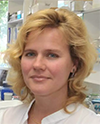CNRS Research Director, May Morris has devoted almost 20 years of research on chemical biology approaches to develop cell cycle biosensors and inhibitors. A portrait to inspire young researchers and femal scientists in particular.
Why are you active in the field of chemical biology?
Because I enjoy the interface between biology and chemistry – developing synthetic or biomimetic tools made by mankind to address unresolved questions in life sciences.
Describe the most intense moment of your career.
I have had several moments of pure joy when obtaining a result of significant importance for a given scientific project and enjoyed times of recognition by my peers. But the most intense moment of my career was probably when I published my first independent piece of work.
Which is the best idea you ever had?
To develop and apply fluorescent biosensor technologies to cancer diagnostics.
Do you have a role-model or a driving force?
Several female scientists have encouraged me in moments of doubt and difficulty in the past. I look up to Barbara Imperiali and the late Cecile Pickart for their sense of creativity and rigour.
The philosophy along which lines you lead your lab?
Teach the basic skills to my students and give them “guided” freedom so they can develop their sense of creativity and build their own experience through their questions and mistakes. In return I expect the best and a sense of respect for what has been taught and given.
Pick a paper you praise for the elegance of its demonstration.
Griss R., Schena A., Reymond L., Patiny L., Werner D., Tinberg C.E., Baker D., Johnsson K., “Bioluminescent sensor proteins for point-ofcare therapeutic drug monitoring”, Nat. Chem. Biol. 2014 Jul.;10(7) :598-603.
Can you shed light on the relevance of inter-disciplinarity for scientific breakthroughs?
Interdisciplinarity is like couples: bringing together fields, 1+1 = 3.
Define research in just three words.
Brainstorming – Hard-work – Pleasure (of discovery).
How do you match the words beauty and science?
If you derive pleasure from the art of science, it is because you see and feel its beauty in its design and application.
A piece of advice you’d like to give to the young generation of researchers?
Don’t be afraid to make mistakes – but learn from them. Don’t accept dogmas – question them. Risk new ideas to break boundaries – it takes a dose of courage but makes a good scientist.
A book, song, poem, music or painting that you spot out and get inspiration from?
Song: Me and Bobby McGee – Janis Joplin
Movie: Chariots of Fire
Book: “The Loneliness of a Long Distance Runner”, by Alan Sillitoe
 May C. Morris obtained her PhD in Biology and Health Sciences at the University of Montpellier, France, in 1997 and completed her postdoctoral training at the Scripps Research Institute, La Jolla, USA. In 2000, she was hired by the CNRS and returned to the Centre of Research on Macromolecular Biochemistry in Montpellier. In 2005, she established her own research group and in 2010, she was promoted CNRS Research Director. In 2014 she moved to the Institute of Biomolecules Max Mousseron, where she is currently in charge of the “Cell Cycle Biosensors and Inhibitors” group within the Department of Amino Acids, Heterocycles, Peptides and Proteins for Health. She was awarded the CNRS Bronze Medal in 2006 and the “Scientist of the Future” award from Languedoc-Roussillon Region in 2009. Dr. Morris is also a Council Board Member of the French “Women in Science” association and has established a Mentoring Programme for Doctoral students of the Biology & Health Doctoral School of the University of Montpellier. She is an Editorial Board member of ChemBioChem and of Frontiers in Chemistry.
May C. Morris obtained her PhD in Biology and Health Sciences at the University of Montpellier, France, in 1997 and completed her postdoctoral training at the Scripps Research Institute, La Jolla, USA. In 2000, she was hired by the CNRS and returned to the Centre of Research on Macromolecular Biochemistry in Montpellier. In 2005, she established her own research group and in 2010, she was promoted CNRS Research Director. In 2014 she moved to the Institute of Biomolecules Max Mousseron, where she is currently in charge of the “Cell Cycle Biosensors and Inhibitors” group within the Department of Amino Acids, Heterocycles, Peptides and Proteins for Health. She was awarded the CNRS Bronze Medal in 2006 and the “Scientist of the Future” award from Languedoc-Roussillon Region in 2009. Dr. Morris is also a Council Board Member of the French “Women in Science” association and has established a Mentoring Programme for Doctoral students of the Biology & Health Doctoral School of the University of Montpellier. She is an Editorial Board member of ChemBioChem and of Frontiers in Chemistry.

Leave a comment
The editors reserve the right not to publish comments or to abridge them.